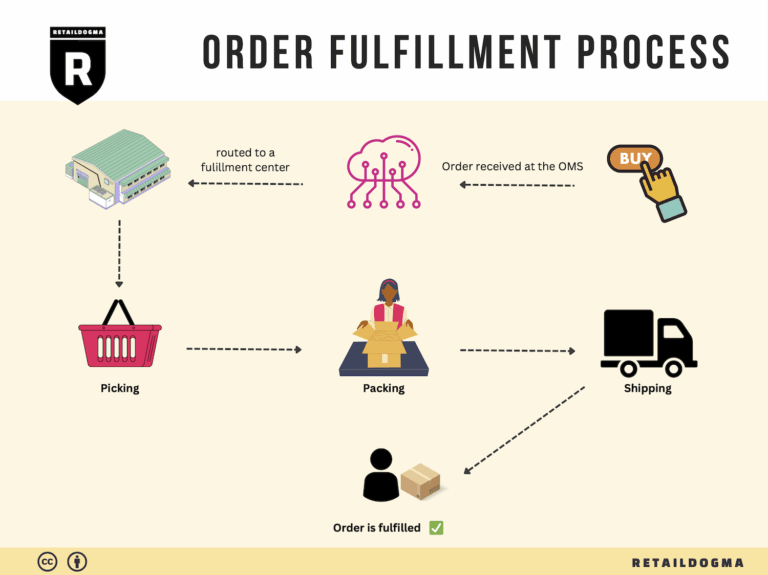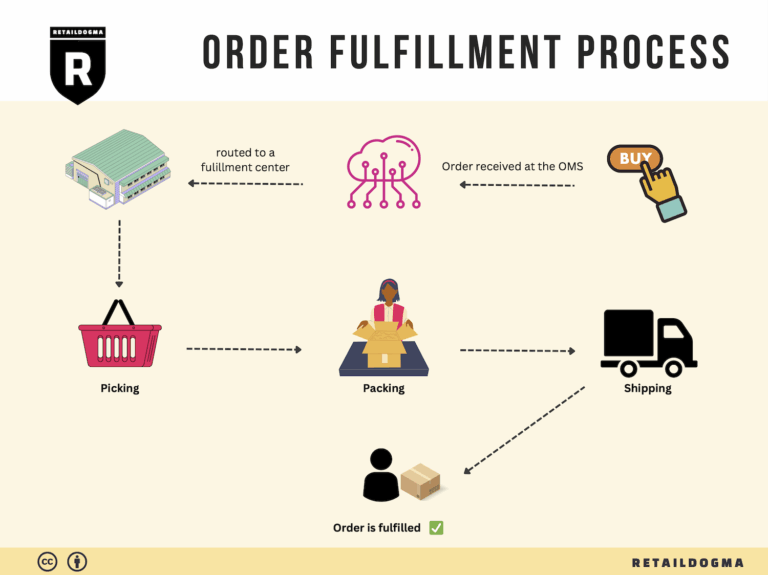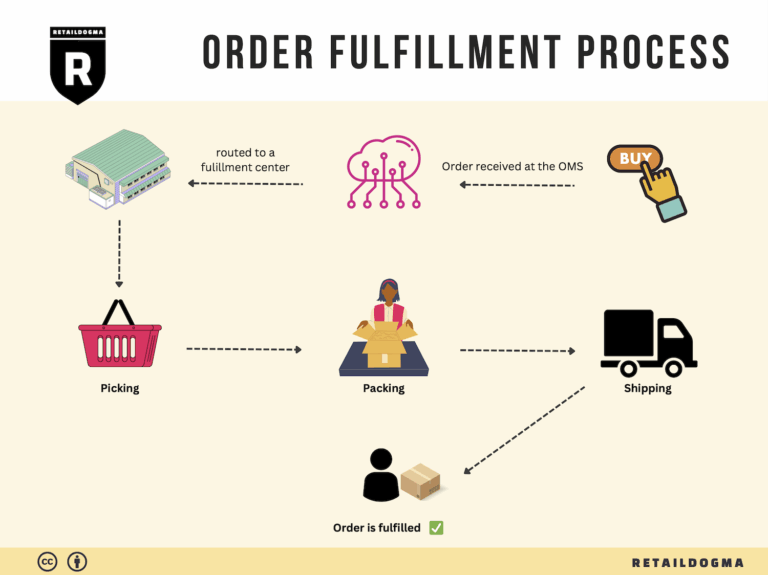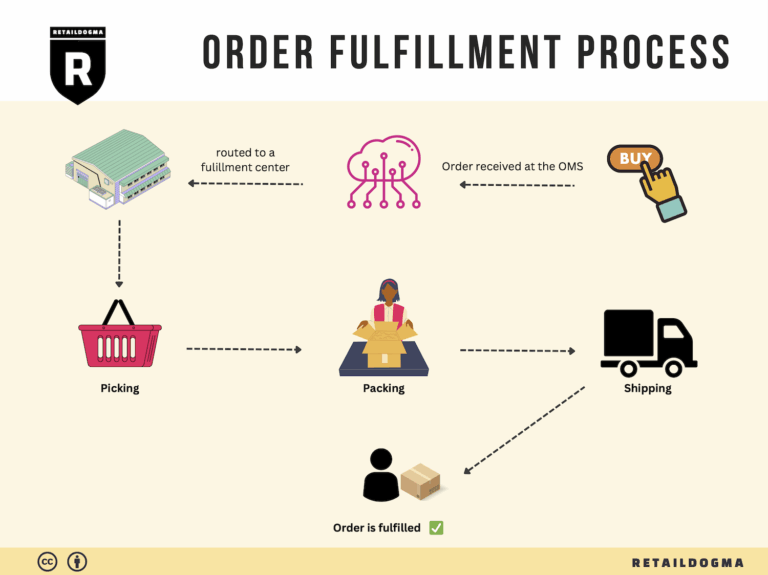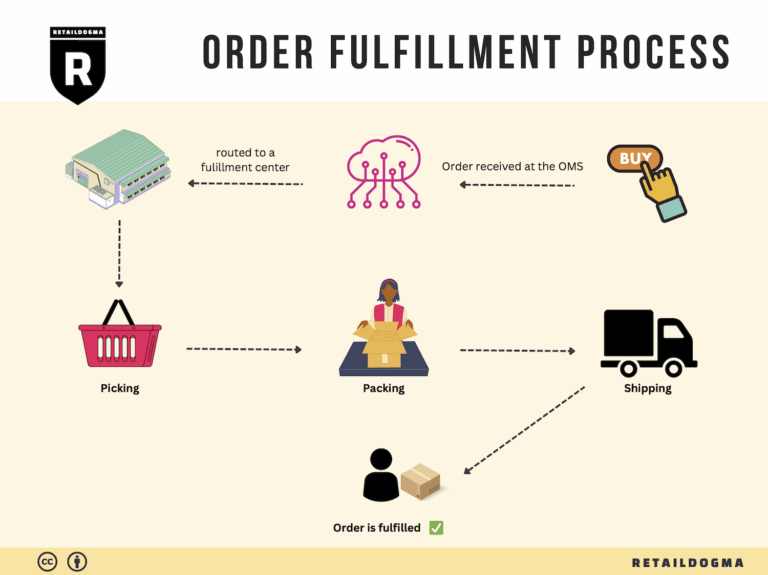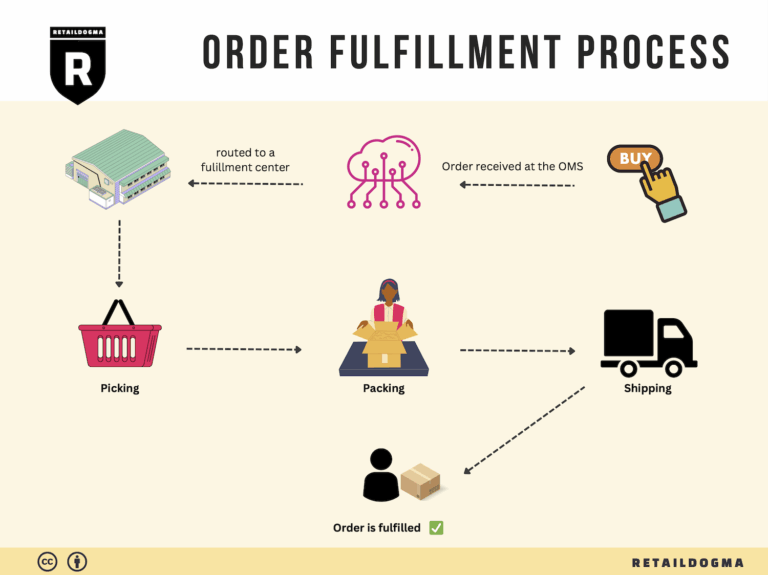What Is A Fulfillment Center? A Complete Guide (2025)
What is E-commerce Fulfillment? An Introduction for Growing Businesses
Understanding E-commerce Fulfillment
As your e-commerce business grows, the excitement of increasing sales can quickly turn into the stress of managing logistics. One of the most common pain points for online retailers is the overwhelming task of packing and shipping orders. This process, known as fulfillment, is crucial for customer satisfaction and can significantly impact your bottom line. Fulfillment simply refers to the steps involved in getting a product from your warehouse to your customer’s doorstep, and it encompasses everything from inventory management to shipping and handling returns.
This guide aims to demystify e-commerce fulfillment for growing businesses by exploring various fulfillment models, including Third-Party Logistics (3PL) and Fulfillment by Amazon (FBA). Each model offers unique advantages depending on your business size, product type, and customer expectations. Understanding these options will help you choose the best approach for your needs.
We will also delve into the core services that fulfillment providers typically offer. These include warehousing, picking and packing, shipping, and customer service. Knowing what services are available can help you streamline your operations and focus on what you do best—growing your business.
Choosing the right fulfillment partner is a critical decision that can affect your operational efficiency and customer satisfaction. We’ll provide practical tips on how to evaluate potential partners, including what questions to ask, what to look for in terms of technology and integration capabilities, and how to assess their reliability and reputation in the industry.
Pricing is another essential aspect of fulfillment that can be confusing for many business owners. We will break down the various pricing structures you might encounter, including per-order fees, storage fees, and shipping costs, helping you to understand how to budget effectively for your logistics operations.
Ultimately, this guide aims to empower you to make informed decisions about your e-commerce logistics. By understanding the fulfillment landscape, you can enhance your operational efficiency, improve customer satisfaction, and position your business for sustainable growth in the competitive online marketplace.
What You’ll Learn In This Guide
- What is E-commerce Fulfillment? An Introduction for Growing Businesses
- The Order Fulfillment Process: From ‘Buy’ Button to Customer’s Door
- Comparing Fulfillment Models: In-House vs. 3PL vs. Dropshipping
- A Deep Dive into Amazon FBA: Pros, Cons, and Who It’s For
- Core Services Offered by Fulfillment Centers
- How to Choose a Fulfillment Partner: A 6-Point Checklist
- Understanding Fulfillment Pricing: A Breakdown of Common Fees
- Frequently Asked Questions (FAQs) about Fulfillment
- Conclusion: Is Outsourcing Fulfillment the Right Move for Your Business?
- Important Disclaimer
The Order Fulfillment Process: From ‘Buy’ Button to Customer’s Door
1. Receiving Inventory
The order fulfillment process begins with receiving inventory at the fulfillment center. This step involves the physical arrival of products from suppliers or manufacturers. Upon arrival, each shipment is checked for accuracy against purchase orders. This is where SKU (Stock Keeping Unit) comes into play; each product is assigned a unique SKU to facilitate tracking and inventory management.
Why is this step important? Accurate receiving is crucial for maintaining inventory integrity and preventing stockouts or overstock situations. If discrepancies occur, they can lead to delays in order fulfillment, impacting customer satisfaction. Therefore, implementing a robust receiving process that includes scanning SKUs helps ensure that the right products are received in the correct quantities.
2. Warehouse Storage
Once inventory is received, the next step is warehouse storage. This involves placing the products in designated areas within the fulfillment center. Efficient storage is achieved through the use of bin locations or shelving systems that are strategically organized based on product demand and size.
The importance of effective warehouse storage cannot be overstated. A well-organized storage system reduces the time spent locating products, thus speeding up the overall fulfillment process. Additionally, it helps prevent damage to goods, as items are stored properly. Implementing inventory management software can assist in tracking stock levels and optimizing storage layouts, ensuring that high-demand items are easily accessible.
3. Order Picking
The third step in the order fulfillment process is order picking, where items are retrieved from storage to fulfill customer orders. This is typically done using pick lists, which are generated based on incoming orders. These lists specify the items and quantities needed for each order, guiding warehouse staff through the picking process.
Order picking is a critical stage because it directly impacts order accuracy and speed. Mistakes made during picking can lead to incorrect shipments, resulting in returns and dissatisfied customers. To enhance picking efficiency, businesses can employ technology such as barcode scanners or pick-to-light systems, which provide visual cues to workers, ensuring that the correct items are selected quickly and accurately.
4. Order Packing
After items are picked, they move to the order packing stage. This step involves securely packaging the products to ensure they arrive at the customer’s door in perfect condition. The packing process includes choosing the right packaging materials, such as boxes, bubble wrap, and tape, as well as generating shipping labels.
The significance of proper packing cannot be overlooked. Well-packed orders reduce the likelihood of damage during transit and enhance the overall customer experience. Additionally, efficient packing can minimize shipping costs by reducing dimensional weight. Implementing packing stations equipped with necessary materials and tools can streamline this process, allowing for faster turnaround times.
5. Shipping & Delivery
The final step in the order fulfillment process is shipping and delivery. Once an order is packed, it is handed over to shipping carriers for delivery to the customer. This stage requires managing logistics effectively, including selecting the best shipping method based on cost, speed, and reliability.
Shipping and delivery are pivotal to customer satisfaction; timely delivery can significantly influence customer loyalty and repeat purchases. Businesses should consider using shipping management software to compare rates from multiple carriers and track shipments in real-time. This not only improves transparency for customers but also helps businesses optimize shipping costs and delivery times.
In conclusion, understanding and optimizing each step of the order fulfillment process is essential for e-commerce businesses aiming to scale. By focusing on receiving inventory, warehouse storage, order picking, order packing, and shipping and delivery, businesses can enhance efficiency, reduce errors, and ultimately improve customer satisfaction.
Comparing Fulfillment Models: In-House vs. 3PL vs. Dropshipping
Fulfillment Model Comparison Table
| Model | Who Handles Inventory | Best For (Business Stage) | Key Advantage | Key Disadvantage |
|---|---|---|---|---|
| In-House Fulfillment | Business (Owner/Staff) | Established businesses | Greater control over operations and quality | Higher overhead costs and resource demands |
| Third-Party Logistics (3PL) | Third-party provider | Growing businesses | Scalability and access to expertise | Less control over inventory and processes |
| Dropshipping | Supplier | Startups and small businesses | Low startup costs and minimal risk | Lower profit margins and potential quality issues |
In-House Fulfillment
In-house fulfillment involves managing the entire supply chain process within your own business premises. This model is most suitable for established businesses that have sufficient resources and a stable customer base. The key advantage of in-house fulfillment is the level of control it offers. Businesses can oversee inventory management, order processing, and shipping, ensuring that quality standards are met consistently. Additionally, having direct control allows for quicker response times to customer inquiries and the ability to implement custom packaging or branding strategies.
However, this model comes with significant challenges. The overhead costs can be substantial, as businesses must invest in warehouse space, inventory management systems, staffing, and logistics infrastructure. Furthermore, as demand fluctuates, businesses may find it difficult to scale operations quickly without incurring additional costs. In-house fulfillment requires a substantial commitment of time and resources, which may not be feasible for all businesses, especially those in the early stages of growth.
Third-Party Logistics (3PL)
Third-party logistics (3PL) providers manage logistics and fulfillment processes on behalf of businesses. This model is particularly advantageous for growing businesses that need to scale efficiently without the burden of managing warehousing and distribution themselves. 3PL providers typically have established networks and expertise in logistics, allowing businesses to leverage their resources and technology to streamline operations.
The primary advantage of using a 3PL is the scalability it offers. As demand increases, businesses can easily adjust their storage and shipping capabilities without the need for major capital investments. Additionally, 3PLs often provide advanced technology solutions that can integrate with e-commerce platforms, offering real-time tracking and analytics that can enhance decision-making. However, the key disadvantage is the loss of direct control over inventory and fulfillment processes. Businesses may encounter challenges in maintaining quality standards and ensuring that the 3PL aligns with their brand values. Moreover, reliance on an external provider can lead to potential communication gaps and delays if not managed effectively.
Dropshipping
Dropshipping is a fulfillment method where the retailer does not hold inventory but instead transfers customer orders directly to the supplier, who then ships the products to the customer. This model is ideal for startups and small businesses looking to minimize upfront costs and risks associated with inventory management. The main advantage of dropshipping is the low barrier to entry; businesses can start selling without the need for significant capital investment in stock or storage facilities.
However, dropshipping also has its drawbacks. The profit margins tend to be lower since retailers often pay wholesale prices to suppliers, which can lead to intense competition on price. Furthermore, quality control can be a significant issue, as businesses have little influence over the product quality or shipping times. This lack of control can result in customer dissatisfaction if products do not meet expectations or if delivery times are delayed. Additionally, businesses relying solely on dropshipping may struggle to build brand loyalty, as the products often lack unique branding or customization options.
In summary, each fulfillment model presents unique advantages and challenges. Businesses must carefully assess their stage of growth, resource availability, and long-term goals when selecting the most appropriate fulfillment strategy. Understanding these models can help businesses optimize their operations and ultimately enhance customer satisfaction.
A Deep Dive into Amazon FBA: Pros, Cons, and Who It’s For
Understanding Fulfillment by Amazon (FBA)
Fulfillment by Amazon (FBA) is a service that allows e-commerce sellers to leverage Amazon’s extensive logistics network to store, pack, and ship their products. By using FBA, sellers can take advantage of Amazon’s vast fulfillment centers, which handle everything from warehousing to customer service. This means that when a customer places an order for a product, Amazon takes care of the entire fulfillment process, including packaging and shipping the product directly to the customer.
The FBA process is streamlined through Amazon Seller Central (ASC), where sellers can manage their inventory, track sales, and monitor performance. Sellers send their products to Amazon’s fulfillment centers, and once they are stored, they become eligible for Amazon Prime, enhancing their visibility and attractiveness to potential buyers.
How FBA Works
-
Inventory Shipment: Sellers prepare their products and ship them to one or more of Amazon’s fulfillment centers. Amazon provides guidelines on how to package and label items to ensure efficient processing.
-
Storage: Once received, products are stored in Amazon’s warehouses. Sellers can view their inventory levels in real-time through ASC.
-
Order Processing: When a customer places an order for a product fulfilled by Amazon, the fulfillment center takes over. Amazon picks, packs, and ships the product directly to the customer.
-
Customer Service: Amazon also handles customer inquiries and returns for FBA products, allowing sellers to focus on other aspects of their business.
-
Payment: After the sale is completed, Amazon deducts its fees from the sale price and disburses the remaining funds to the seller.
Pros of Using FBA
1. Prime Eligibility
One of the most significant advantages of FBA is that it qualifies products for Amazon Prime. This increases visibility and attractiveness to millions of Prime members who prefer fast, free shipping. The Prime badge can significantly enhance conversion rates and sales volume.
2. Enhanced Customer Trust
Selling through FBA lends credibility to sellers. Customers often feel more secure purchasing items fulfilled by Amazon, as they trust the company’s customer service and return policies. This can lead to higher sales and positive reviews, which are critical for e-commerce success.
3. Multi-Channel Fulfillment
FBA is not limited to Amazon’s marketplace. Sellers can use FBA for orders from their own websites or other platforms, allowing them to centralize their logistics operations. This capability simplifies inventory management and shipping processes across multiple sales channels.
4. Scalability
FBA allows sellers to scale their businesses without the need to invest in warehousing and logistics infrastructure. As demand grows, sellers can easily increase their inventory levels and leverage Amazon’s expansive network.
Cons of Using FBA
1. High Fees
FBA involves various fees, including storage fees for keeping products in Amazon’s fulfillment centers and fulfillment fees for processing orders. These costs can add up, especially for slow-moving inventory, potentially squeezing profit margins.
2. Strict Inventory Rules
Amazon has stringent guidelines regarding inventory management, including policies on product condition, labeling, and packaging. Sellers must adhere to these rules, or they risk incurring additional fees or having their inventory returned.
3. Commingling Risks
When using FBA, products from different sellers can be stored together, leading to a risk known as commingling. If a customer returns a product, it may not be the exact item sent by the original seller. This can create challenges for brand integrity and customer satisfaction.
4. Loss of Control
By outsourcing fulfillment to Amazon, sellers relinquish some control over the customer experience. Issues such as packaging quality, shipping times, and customer service are managed by Amazon, which may not always align with a seller’s brand standards.
Who is FBA Best For?
Fulfillment by Amazon is ideal for various types of sellers, but it particularly suits:
-
Small to Medium-Sized Businesses: Businesses looking to scale their operations without significant upfront investment in logistics can benefit greatly from FBA’s infrastructure.
-
Sellers with High Volume: Businesses that can maintain a steady flow of sales will find FBA’s efficiency and fast shipping capabilities advantageous.
-
Brands Focused on Growth: Sellers aiming to grow their brand presence on Amazon and reach a broader customer base can leverage FBA to enhance visibility and trust.
-
Multi-Channel Sellers: Businesses that sell across various platforms can streamline their fulfillment processes by utilizing FBA for all their orders, simplifying logistics.
In conclusion, FBA offers a compelling opportunity for e-commerce sellers to streamline operations and reach a vast audience. However, it is essential to weigh the pros and cons carefully and consider whether FBA aligns with your business model and growth objectives. By understanding the intricacies of FBA, sellers can make informed decisions that support their operational goals and enhance their overall customer experience.
Core Services Offered by Fulfillment Centers
Inventory Management & Warehousing
Fulfillment centers provide robust inventory management and warehousing solutions that are essential for e-commerce businesses looking to scale. These centers utilize advanced inventory tracking systems that allow businesses to monitor stock levels in real-time. This capability ensures that businesses can quickly assess their inventory status, enabling them to make informed decisions about restocking and order fulfillment.
Benefits:
1. Optimized Stock Levels: With accurate inventory management, businesses can maintain optimal stock levels, reducing the risk of overstocking or stockouts. This balance is crucial for maintaining cash flow and ensuring customer satisfaction.
2. Space Efficiency: Fulfillment centers offer specialized storage solutions, including climate-controlled environments for sensitive products. This means that businesses can store a diverse range of products without compromising on quality.
3. Scalability: As e-commerce businesses grow, their inventory needs may fluctuate significantly. Utilizing a fulfillment center allows for easy scalability, accommodating seasonal demands or unexpected spikes in sales without the need for businesses to invest in additional warehouse space.
Pick and Pack Services
One of the hallmark services provided by fulfillment centers is pick and pack services. This process involves selecting items from the warehouse shelves (picking) and packaging them for shipment (packing). Fulfillment centers employ automated systems and trained staff to ensure that this process is executed with precision and efficiency.
Benefits:
1. Speed and Accuracy: Automated picking systems reduce the time taken to fulfill orders, ensuring that products are dispatched quickly. High accuracy in picking minimizes the chances of errors, which can lead to customer dissatisfaction and increased return rates.
2. Customized Packaging: Fulfillment centers often provide tailored packing solutions that enhance the unboxing experience for customers. This can include branded packaging, gift wrapping, or eco-friendly materials, contributing to a positive brand image.
3. Order Scalability: As e-commerce businesses experience growth, fulfillment centers can handle increased order volumes without compromising service quality. This flexibility allows businesses to focus on marketing and sales rather than operational logistics.
Kitting and Assembly
Kitting and assembly services offered by fulfillment centers involve bundling individual items together into ready-to-sell kits or completing assembly tasks before shipping. This service is particularly beneficial for businesses that sell products that are often purchased together or require assembly before use.
Benefits:
1. Increased Sales Opportunities: By offering bundled products, businesses can encourage customers to purchase more items at once, enhancing average order value. Kitting can also simplify the shopping experience by presenting related products as a single package.
2. Reduced Handling Time: Pre-assembled products can be shipped faster, reducing the handling time at the fulfillment center and providing quicker delivery to customers. This can be a significant competitive advantage in today’s fast-paced e-commerce environment.
3. Customization Options: Businesses can offer customers customizable kits based on preferences or trends, allowing for a personalized shopping experience that can lead to increased customer loyalty and repeat purchases.
Returns Management (Reverse Logistics)
Returns management, often referred to as reverse logistics, is a critical service provided by fulfillment centers. This process involves handling product returns efficiently, ensuring that items are processed, restocked, or disposed of appropriately. Effective returns management is vital for maintaining customer trust and satisfaction.
Benefits:
1. Streamlined Returns Process: Fulfillment centers implement systems to manage returns quickly and efficiently, allowing businesses to handle customer returns with ease. This capability is essential for maintaining customer satisfaction, as a smooth returns process can significantly enhance the shopping experience.
2. Data Insights: Returns management systems provide valuable data insights into return reasons and patterns, helping businesses identify potential issues with products or services. This feedback loop can drive improvements in product quality and customer service.
3. Cost Management: By efficiently processing returns, fulfillment centers help businesses minimize losses associated with returned products. Items can be quickly restocked and made available for resale, reducing the impact on inventory levels and cash flow.
In conclusion, partnering with a fulfillment center offers e-commerce businesses a comprehensive suite of services that streamline operations and enhance customer experiences. From inventory management to returns processing, these core services play a pivotal role in scaling logistics effectively while allowing businesses to focus on growth and customer engagement.
How to Choose a Fulfillment Partner: A 6-Point Checklist
Location & Warehouse Network
Importance: The location of your fulfillment partner’s warehouses plays a crucial role in shipping times and costs. A well-distributed network can significantly reduce delivery times, enhance customer satisfaction, and optimize shipping expenses.
Questions to Ask:
– Where are your fulfillment centers located, and how do they align with our target markets?
– Can you provide a map or a list of your warehouse locations?
– Do you have facilities in regions that can help us reach our customers quickly and efficiently?
– How do you manage shipping costs to different regions?
Technology & Integrations
Importance: Advanced technology and seamless integrations are essential for managing inventory, orders, and customer data efficiently. A fulfillment partner should offer robust software that integrates with your e-commerce platform, providing real-time data and analytics.
Questions to Ask:
– What technology platforms do you use for inventory management and order fulfillment?
– How do your systems integrate with major e-commerce platforms like Shopify, Amazon, or WooCommerce?
– Do you provide real-time tracking for shipments and inventory levels?
– Can your technology scale with our growth and adapt to our changing needs?
Specializations (e.g., Cold Storage, Oversized Items)
Importance: Depending on your product type, you may need a partner that specializes in specific areas, such as cold storage for perishables or handling oversized items. Understanding a partner’s specializations ensures they can meet your unique requirements effectively.
Questions to Ask:
– What types of products do you specialize in handling?
– Do you have facilities that cater to specialized needs, such as temperature-controlled storage or oversized items?
– Can you accommodate unique packaging requirements or custom kitting?
– How do you ensure compliance with regulations for specialized products?
Scalability & Capacity
Importance: As your business grows, your fulfillment needs will likely change. It’s essential to choose a partner that can scale operations to meet increasing demand without sacrificing quality or efficiency.
Questions to Ask:
– What is your current capacity for handling orders, and how do you plan to scale as our business grows?
– Have you handled rapid growth for other clients, and can you share examples?
– What processes do you have in place to manage peak seasons or unexpected surges in demand?
– How do you ensure that you can maintain service quality during periods of rapid growth?
Pricing and Contracts
Importance: Understanding the pricing structure and contract terms is vital for budgeting and long-term planning. Transparent pricing helps avoid unexpected costs that can erode your profit margins.
Questions to Ask:
– Can you provide a detailed breakdown of your pricing structure, including any hidden fees?
– What are the terms of the contract, and is there flexibility for renegotiation?
– Do you offer volume discounts or incentives for long-term contracts?
– How do you handle returns, and what costs are associated with that process?
Customer Support & Reviews
Importance: Exceptional customer support is crucial for resolving issues quickly and maintaining smooth operations. Furthermore, reviews and testimonials can provide insight into a partner’s reliability and service quality.
Questions to Ask:
– What customer support options do you offer (e.g., phone, email, chat)?
– What are your average response times for customer support inquiries?
– Can you provide references or testimonials from current clients?
– How do you handle issues such as lost shipments or inventory discrepancies?
Conclusion
Choosing the right fulfillment partner is a critical decision for any e-commerce business. By using this checklist, you can systematically evaluate potential partners based on key criteria that align with your business needs. The right partner will not only enhance your operational efficiency but also contribute to your overall growth strategy, ensuring that you can scale effectively while providing excellent service to your customers.
Understanding Fulfillment Pricing: A Breakdown of Common Fees
Initial Setup Fees
When partnering with a fulfillment center like Amazon’s FBA, the initial setup fees are often the first cost you encounter. These fees can vary widely depending on the complexity of your inventory and the specific services you require. Generally, initial setup fees cover the costs associated with onboarding your products into the system, which may include account setup, training on the fulfillment software, and the first batch of inventory received.
Typically, the setup fee structure could be a flat rate or a percentage of the first month’s anticipated sales volume. For smaller businesses, it’s crucial to understand what these fees cover and whether they include any ongoing services, such as customer support or integration with your e-commerce platform. Always clarify what is included to avoid unexpected expenses later.
Receiving Fees
Receiving fees are charged each time a shipment of products is sent to the fulfillment center. This fee is calculated based on the number of items in the shipment and can vary based on the size and weight of the items. For example, larger or heavier products may incur higher receiving fees than smaller items.
To minimize these costs, businesses should consider optimizing their shipments by consolidating orders and ensuring that all products are properly labeled and packaged according to the fulfillment center’s guidelines. This not only speeds up the receiving process but can also reduce fees associated with additional handling.
Storage Fees (per pallet/bin)
Storage fees are charged for keeping your products in the fulfillment center’s warehouse. These fees are typically calculated on a monthly basis and are based on the volume of space your inventory occupies, often measured in cubic feet or pallets. Storage fees can fluctuate based on the time of year, with higher rates during peak seasons when demand increases.
To manage storage costs effectively, businesses should regularly audit their inventory levels and rotate stock efficiently. Implementing a just-in-time inventory strategy can also help minimize storage needs and reduce fees, especially for slow-moving items. Additionally, understanding the seasonal trends in your inventory can aid in better planning and cost control.
Pick & Pack Fees (per item/order)
Pick & pack fees are incurred each time an order is fulfilled. This fee covers the costs associated with picking the items from the shelves, packing them appropriately, and preparing them for shipment. The calculation is usually based on the number of items included in the order; therefore, larger orders may attract higher fees.
To optimize these fees, businesses can encourage customers to purchase multiple items in a single order, thus reducing the average pick & pack fee per item. Additionally, understanding the fulfillment center’s processes can help you design packaging that is efficient for the pick and pack operation, potentially reducing time and costs.
Shipping Fees
Shipping fees are one of the most significant expenses associated with fulfillment. These fees can vary based on the destination, the shipping method selected (standard, expedited, etc.), and the weight and dimensions of the package. Many fulfillment centers offer tiered shipping rates based on volume, so larger businesses often benefit from lower per-unit shipping costs.
To manage shipping fees, businesses should analyze their shipping options regularly and consider using fulfillment centers that offer discounted rates through partnerships with major carriers. Additionally, implementing a strategy for free shipping thresholds can encourage larger orders while controlling shipping expenses.
Tips for Getting an Accurate Quote
-
Detailed Inventory Information: Provide comprehensive details about your products, including size, weight, and any special handling requirements. This will help fulfillment centers give you a more accurate estimate.
-
Understand Fee Structures: Familiarize yourself with the various fee structures and how they apply to your specific business model. Ask for clarity on any terms or conditions that may affect pricing.
-
Request a Breakdown: When seeking quotes, ask for a detailed breakdown of all potential fees. This should include setup, receiving, storage, pick & pack, and shipping fees.
-
Negotiate: Don’t hesitate to negotiate terms, especially if you anticipate a high volume of business. Many fulfillment centers may offer discounts or flexible terms for long-term partnerships.
-
Test with a Trial Run: If possible, conduct a trial run with the fulfillment center to gauge their services and pricing. This can provide valuable insights into actual costs and service quality.
By understanding these common fulfillment pricing models and taking proactive steps to manage costs, e-commerce businesses can better navigate the complexities of logistics and focus on scaling their operations effectively.
Frequently Asked Questions (FAQs) about Fulfillment
1. What is the SBD6 Amazon Fulfillment Center?
The SBD6 Amazon Fulfillment Center is a state-of-the-art logistics facility located in Ontario, California. It is part of Amazon’s extensive network of fulfillment centers that handle the storage, picking, packing, and shipping of products for sellers using the Fulfillment by Amazon (FBA) service. This center plays a crucial role in ensuring fast delivery times for Amazon customers.
2. How does the fulfillment process work at SBD6?
At SBD6, products are received, stored, and organized using advanced automation and technology. When an order is placed, the fulfillment process begins with picking the item from storage, packing it securely, and shipping it out to the customer. This efficiency is a key reason why Amazon can offer rapid delivery services, often within one or two days.
3. What is the difference between a warehouse and a fulfillment center?
A warehouse primarily focuses on storing goods and may not have the infrastructure for order processing or shipping. In contrast, a fulfillment center, like SBD6, is designed for end-to-end logistics, including receiving, storing, picking, packing, and shipping products directly to customers. Fulfillment centers are integral to e-commerce, as they streamline the entire process from order placement to delivery.
4. What is Fulfillment by Amazon (FBA)?
Fulfillment by Amazon (FBA) is a service that allows e-commerce sellers to store their products in Amazon’s fulfillment centers, including SBD6. Amazon takes care of storage, packaging, shipping, and customer service. This enables sellers to reach a wider audience while benefiting from Amazon’s logistics capabilities, thus improving their sales potential.
5. How much do fulfillment services cost?
The cost of fulfillment services can vary widely based on several factors, including storage fees, order processing fees, and shipping costs. For FBA, Amazon charges sellers based on the size and weight of the products stored and shipped. It’s essential for business owners to analyze these costs against their profit margins to ensure profitability.
6. What types of products can be stored at the SBD6 Fulfillment Center?
The SBD6 Fulfillment Center can accommodate a wide range of products, including electronics, clothing, home goods, and more. However, there are restrictions on certain items, such as hazardous materials or perishables. Sellers should refer to Amazon’s guidelines to ensure their products comply with storage regulations.
7. How can I track my inventory at SBD6?
Sellers can monitor their inventory levels at SBD6 through Amazon Seller Central, the platform’s management dashboard. This tool provides real-time updates on inventory status, sales, and order fulfillment, allowing sellers to manage their stock effectively and make informed decisions.
8. What are the benefits of using the SBD6 Fulfillment Center for my business?
Utilizing the SBD6 Fulfillment Center offers several advantages, including:
– Fast Shipping: Access to Amazon’s rapid shipping network.
– Increased Visibility: Products stored at FBA centers are eligible for Prime shipping, boosting visibility to millions of customers.
– Customer Service: Amazon handles customer inquiries and returns, freeing up time for sellers to focus on other aspects of their business.
9. Can I use SBD6 for international shipping?
Yes, sellers can use the SBD6 Fulfillment Center to facilitate international shipping through Amazon’s global logistics network. However, sellers must ensure their products comply with international regulations and shipping requirements.
10. What is a 3PL, and how does it relate to fulfillment centers?
A Third-Party Logistics provider (3PL) is a company that offers logistics services, including warehousing, fulfillment, and shipping, on behalf of other businesses. While Amazon’s fulfillment centers, like SBD6, can be considered a form of 3PL, businesses may also choose independent 3PLs for their logistics needs based on specific requirements or preferences for flexibility and control over their supply chain.
Conclusion: Is Outsourcing Fulfillment the Right Move for Your Business?
Evaluating the Benefits of Outsourcing Fulfillment
Outsourcing your fulfillment process can significantly enhance your e-commerce business’s efficiency and growth potential. One of the most compelling advantages is the time savings it offers. By leveraging a fulfillment service, you can redirect your focus from the complexities of logistics—such as inventory management, packing, and shipping—towards strategic initiatives like marketing and product development. This shift allows for more agile decision-making and innovation, which are crucial for scaling in today’s competitive marketplace.
Moreover, partnering with a fulfillment service provides scalability that in-house operations often struggle to match. As your sales volumes increase, a fulfillment partner can seamlessly adapt to your evolving needs, ensuring that you can meet customer demand without compromising service quality. This flexibility is particularly valuable during peak seasons or promotional events when order volumes can fluctuate dramatically.
Additionally, fulfillment services bring expertise to the table. With specialized knowledge in logistics and shipping, these partners can optimize your supply chain processes, reducing costs and improving delivery times. They often employ advanced technologies and methodologies that might be prohibitively expensive for individual businesses to implement independently.
However, the key to unlocking these benefits lies in selecting the right fulfillment partner. A misaligned partnership can lead to service disruptions and customer dissatisfaction. Therefore, it’s crucial to conduct thorough research and due diligence to ensure that the partner you choose aligns with your business goals.
Call to Action
To determine if outsourcing fulfillment is the right move for your business, start by auditing your current shipping processes. Analyze your operational bottlenecks, costs, and capacity for growth. This assessment will provide clarity on whether a fulfillment partner could enhance your efficiency and help you scale your business effectively. Don’t hesitate to explore the options available, as the right fulfillment partner could be a game-changer in your journey to success.
Important Disclaimer
⚠️ Important Disclaimer
The information in this guide is for educational purposes. Fulfillment services, pricing, and platform features change frequently. Always conduct your own due diligence and consult with providers directly before making business decisions.

